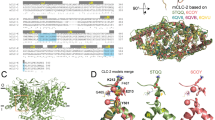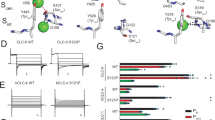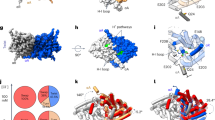Abstract
Ion channels have historically been viewed as distinct from secondary active transporters. However, the recent discovery that the CLC 'chloride channel' family is made up of both channels and active transporters has led to the hypothesis that the ion-transport mechanisms of these two types of membrane proteins may be similar. Here we use single-channel analysis to demonstrate that ClC-0 channel gating (opening and closing) involves the transmembrane movement of protons. This result indicates that ClC-0 is a 'broken' Cl−/H+ antiporter in which one of the conformational states has become leaky for chloride ions. This finding clarifies the evolutionary relationship between the channels and transporters and conveys that similar mechanisms and analogous protein movements are used by both.
This is a preview of subscription content, access via your institution
Access options
Subscribe to this journal
Receive 12 print issues and online access
$189.00 per year
only $15.75 per issue
Buy this article
- Purchase on Springer Link
- Instant access to full article PDF
Prices may be subject to local taxes which are calculated during checkout




Similar content being viewed by others
Change history
27 July 2008
Supplementary information is available on the Nature Structural & Molecular Biology website
References
Jentsch, T.J., Poet, M., Fuhrmann, J.C. & Zdebik, A.A. Physiological functions of CLC Cl− channels gleaned from human genetic disease and mouse models. Annu. Rev. Physiol. 67, 779–807 (2005).
Puljak, L. & Kilic, G. Emerging roles of chloride channels in human diseases. Biochim. Biophys. Acta 1762, 404–413 (2006).
Sile, S., Vanoye, C.G. & George, A.L. Jr. Molecular physiology of renal ClC chloride channels/transporters. Curr. Opin. Nephrol. Hypertens. 15, 511–516 (2006).
Stein, W.D. Carriers and Pumps. An Introduction to Membrane Transport (Academic, San Diego, CA, 1990).
Chen, M.F. & Chen, T.Y. Different fast-gate regulation by external Cl− and H+ of the muscle-type ClC chloride channels. J. Gen. Physiol. 118, 23–32 (2001).
Hanke, W. & Miller, C. Single chloride channels from Torpedo electroplax. Activation by protons. J. Gen. Physiol. 82, 25–45 (1983).
Miller, C. ClC chloride channels viewed through a transporter lens. Nature 440, 484–489 (2006).
Chen, T.Y. Structure and function of CLC channels. Annu. Rev. Physiol. 67, 809–839 (2005).
Dutzler, R. The ClC family of chloride channels and transporters. Curr. Opin. Struct. Biol. 16, 439–446 (2006).
Matulef, K. & Maduke, M. The CLC 'chloride channel' family: revelations from prokaryotes. Mol. Membr. Biol. 24, 342–350 (2007).
Richard, E.A. & Miller, C. Steady-state coupling of ion-channel conformations to a transmembrane ion gradient. Science 247, 1208–1210 (1990).
Hill, T.L. Free Energy Transduction in Biology (Academic, New York, NY, 1977).
Accardi, A. & Miller, C. Secondary active transport mediated by a prokaryotic homologue of ClC Cl− channels. Nature 427, 803–807 (2004).
Picollo, A. & Pusch, M. Chloride/proton antiporter activity of mammalian CLC proteins ClC-4 and ClC-5. Nature 436, 420–423 (2005).
Scheel, O., Zdebik, A.A., Lourdel, S. & Jentsch, T.J. Voltage-dependent electrogenic chloride/proton exchange by endosomal CLC proteins. Nature 436, 424–427 (2005).
Traverso, S., Zifarelli, G., Aiello, R. & Pusch, M. Proton sensing of ClC-0 mutant E166D. J. Gen. Physiol. 127, 51–65 (2006).
Dutzler, R., Campbell, E.B. & MacKinnon, R. Gating the selectivity filter in ClC chloride channels. Science 300, 108–112 (2003).
Chen, M.F. & Chen, T.Y. Side-chain charge effects and conductance determinants in the pore of ClC-0 chloride channels. J. Gen. Physiol. 122, 133–145 (2003).
Engh, A.M. & Maduke, M. Cysteine accessibility in ClC-0 supports conservation of the ClC intracellular vestibule. J. Gen. Physiol. 125, 601–617 (2005).
Estevez, R. et al. Conservation of chloride channel structure revealed by an inhibitor binding site in ClC-1. Neuron 38, 47–59 (2003).
Accardi, A. et al. Separate ion pathways in a Cl−/H+ exchanger. J. Gen. Physiol. 126, 563–570 (2005).
Saviane, C., Conti, F. & Pusch, M. The muscle chloride channel ClC-1 has a double-barreled appearance that is differentially affected in dominant and recessive myotonia. J. Gen. Physiol. 113, 457–468 (1999).
Accardi, A. & Pusch, M. Fast and slow gating relaxations in the muscle chloride channel CLC-1. J. Gen. Physiol. 116, 433–444 (2000).
Aickin, C.C. Intracellular pH regulation by vertebrate muscle. Annu. Rev. Physiol. 48, 349–361 (1986).
Nguitragool, W. & Miller, C. Inaugural article: CLC Cl−/H+ transporters constrained by covalent cross-linking. Proc. Natl. Acad. Sci. USA 104, 20659–20665 (2007).
Zdebik, A.A. et al. Determinants of anion-proton coupling in mammalian endosomal CLC proteins. J. Biol. Chem. 283, 4219–4227 (2007).
DeFelice, L.J. & Goswami, T. Transporters as channels. Annu. Rev. Physiol. 69, 87–112 (2007).
Miller, C. A leak in the EAATs. Nat. Struct. Mol. Biol. 14, 356–357 (2007).
Pusch, M. Structural insights into chloride and proton-mediated gating of CLC chloride channels. Biochemistry 43, 1135–1144 (2004).
Aromataris, E.C. & Rychkov, G.Y. ClC-1 chloride channel: matching its properties to a role in skeletal muscle. Clin. Exp. Pharmacol. Physiol. 33, 1118–1123 (2006).
Jentsch, T.J., Steinmeyer, K. & Schwarz, G. Primary structure of Torpedo marmorata chloride channel isolated by expression cloning in Xenopus oocytes. Nature 348, 510–514 (1990).
Acknowledgements
We thank K. Matulef for help with the data analysis and R. Blaustein, B. Kobertz, R. Lewis, R. Reimer, J. Huguenard and members of the Maduke laboratory for comments on the manuscript. This work was supported by the US National Institutes of Health grant R01 GM070773 and by the Mathers Foundation. J.L. is supported by the Human Frontiers Science Program.
Author information
Authors and Affiliations
Contributions
J.L. collected the experimental data; J.L. and M.M. designed the experiments, analyzed the data and wrote the manuscript.
Corresponding author
Supplementary information
Supplementary Text and Figures
Supplementary Figure 1 (PDF 65 kb)
Rights and permissions
About this article
Cite this article
Lísal, J., Maduke, M. The ClC-0 chloride channel is a 'broken' Cl−/H+ antiporter. Nat Struct Mol Biol 15, 805–810 (2008). https://doi.org/10.1038/nsmb.1466
Received:
Accepted:
Published:
Issue Date:
DOI: https://doi.org/10.1038/nsmb.1466
This article is cited by
-
Helix O modulates voltage dependency of CLC-1
Pflügers Archiv - European Journal of Physiology (2017)
-
A Pore Idea: the ion conduction pathway of TMEM16/ANO proteins is composed partly of lipid
Pflügers Archiv - European Journal of Physiology (2016)
-
13C NMR detects conformational change in the 100-kD membrane transporter ClC-ec1
Journal of Biomolecular NMR (2015)
-
Conformational changes required for H+/Cl− exchange mediated by a CLC transporter
Nature Structural & Molecular Biology (2014)
-
Molecular determinants of common gating of a ClC chloride channel
Nature Communications (2013)



